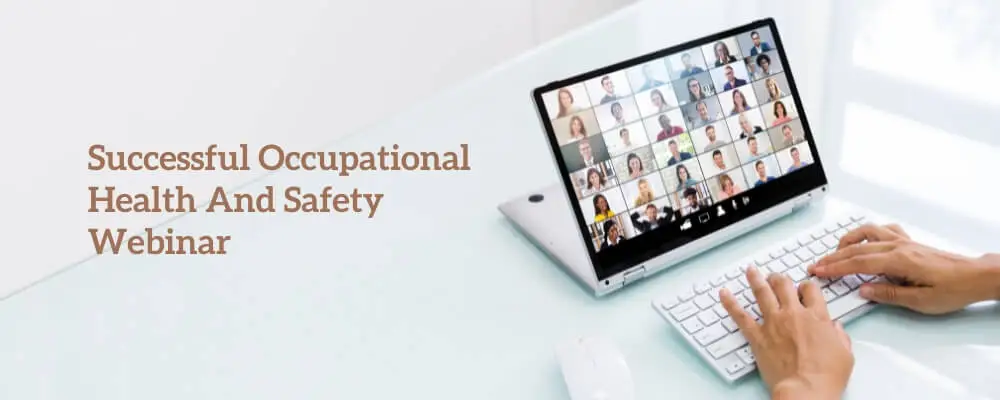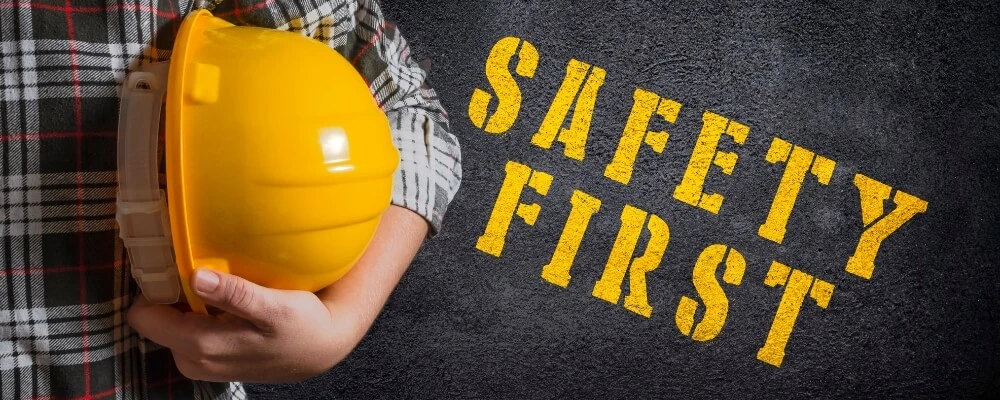In today’s digital age, the need to disseminate critical information about workplace safety and health practices extends beyond physical seminars and workshops. Enter the realm of Occupational Health and Safety (OHS) webinars – an innovative and effective medium to reach, educate, and engage a global audience. With the rising emphasis on creating safer work environments and the challenges posed by geographical constraints, varying time zones, or even global crises like pandemics, OHS webinars are more relevant than ever. But how does one ensure the success of such an online event?
This blog will guide you through the intricacies of planning, organizing, and executing a compelling OHS webinar that educates and captivates its attendees. Whether you’re a seasoned professional or a newbie stepping into the world of virtual seminars, this guide is tailored for you.
Occupational Health And Safety Webinar
An Occupational Health and Safety (OHS) webinar is an online seminar or workshop that focuses on topics related to workplace health, safety, and well-being. Given that it’s a webinar, it is conducted over the Internet, allowing participants from various locations to join without needing physical presence. Here’s a more detailed definition:
A digital learning or informative session held online addresses issues, best practices, regulations, trends, and innovations related to ensuring the safety and health of employees in a workplace. These webinars can be live, where attendees can interact in real-time with the presenters or pre-recorded and viewed later.
The topics covered in an OHS webinar can vary widely, including but not limited to:
- Introduction to OHS standards and regulations.
- Best practices in workplace safety.
- Ergonomics and its importance.
- Handling hazardous materials.
- Mental health and well-being at work.
- Training for specific equipment or machinery.
- Updates on regulations or laws related to workplace safety.
- Case studies showcasing real-world incidents and the lessons learned.
Such webinars are typically attended by safety professionals, HR personnel, managers, and sometimes the general workforce, depending on the topic. The primary goal of these webinars is to disseminate knowledge, foster best practices, and ensure workplaces are safe and compliant with regulations.

Benefits Of Occupational Health And Safety Webinar
Occupational Health and Safety (OHS) webinars offer a range of benefits for both the hosting organization and the participants. Here are some of the primary benefits:
- Cost-Effective Training: Webinars eliminate the need for physical venues, printed materials, and travel, making them a cost-effective method for delivering training or information.
- Geographical Reach: They allow participants from different locations, even globally, to attend without the need to travel. This facilitates a wider distribution of essential safety information.
- Flexible Learning: Many OHS webinars are recorded, allowing participants to view the content conveniently, making it suitable for those who cannot attend live sessions.
- Interactive: Modern webinar platforms offer features like polls, Q&A sessions, and chat, enabling real-time interaction between presenters and attendees.
- Standardized Information: Webinars ensure everyone gets the same information, reducing the risk of misinformation or misinterpretation.
- Immediate Updates: They offer a platform to quickly disseminate new regulations, guidelines, or safety procedures to a wide audience.
- Expert Access: Webinars can bring together experts from various fields or locations that might be difficult to gather in a physical seminar. Participants get the opportunity to interact with and learn from these experts directly.
- Networking Opportunities: Even in a digital space, webinars provide a platform for professionals to network, discuss, and share experiences or solutions to common challenges.
- Resource Efficiency: Without physical setups, webinars can be organized with minimal resources, making them an environmentally friendly option.
- Enhanced Engagement: Multimedia elements like videos, animation videos, and graphics can be integrated into webinars to make them more engaging than traditional presentations.
- Feedback and Analysis: Many webinar platforms provide analytics, such as participation rates, engagement metrics, and survey results. This data can help organizations refine their content and approach for future sessions.
- Safety: In situations where gathering in physical spaces becomes risky, such as during pandemics, webinars provide a safe way to continue essential OHS training and updates.
- Continuous Learning: Employees or stakeholders can revisit the webinar content multiple times if recorded, reinforcing their learning and understanding.
- Documentation: Webinars can be archived and serve as a valuable resource for future reference or for those who couldn’t attend the original session.
In essence, OHS webinars are an effective tool in the modern digital age, offering a blend of convenience, efficiency, and reach that traditional seminar might not always provide.

How To Host A Successful Occupational Health And Safety Webinar
Hosting a successful Occupational Health and Safety (OHS) webinar requires careful planning, content, engaging presentation techniques, and effective promotion. Here are steps to guide you through the process:
1. Understand Your Audience
Grasping the demographics and professional backgrounds of your attendees is crucial. You should be clear on whether you are addressing Occupational Health and Safety (OHS) experts, business executives, on-the-ground workers, or a mix of these groups. Moreover, your presentation’s content and tone should align with their expertise level. For instance, an audience comprised mainly of seasoned OHS professionals might appreciate deeper insights, whereas beginners would benefit more from a basic, foundational approach.
2. Choose a Relevant Topic
The world of OHS is vast, and it’s essential to zone in on topics that resonate most with your audience. It might be beneficial to delve into current challenges and emerging trends within the industry. To ensure maximum relevance, consider running a pre-webinar survey. This allows potential attendees to voice their interests and lets you tailor the content accordingly.
3. Prepare High-Quality Content
The foundation of a successful webinar lies in its content. By weaving together real-world case studies with empirical data, such as statistics, you add credibility to your presentation. Furthermore, integrating best practices and updates from regulatory bodies ensures that attendees receive a comprehensive view of the topic. However, merely presenting data isn’t enough; it provides actionable insights and strategies that the attendees can readily implement in their respective workspaces.
4. Pick the Right Platform
The technical backbone of your webinar, the platform, plays a pivotal role in its success. Options like Zoom, Webex, Microsoft Teams, and GoToWebinar are popular choices due to their robust feature sets. Ensuring the chosen platform can comfortably handle your expected number of attendees is essential. Equally important are features like Q&A sections, polls for real-time feedback, and recording capabilities for those who might want to revisit the session.

5. Promote Your Webinar
A fantastic webinar means little if there’s no audience. Leverage multiple channels such as email campaigns, social media shoutouts, partnerships with other organizations, and promotion on your company website to attract a broader audience. Consider releasing teaser content like brief blog entries or sneak-peek videos related to the webinar’s topic to pique interest.
6. Engage Your Audience
How you deliver your content can make or break your webinar. Initiate with a compelling introduction to hook your attendees from the get-go. Throughout the presentation, use visual aids like slides or infographics to reinforce your points and maintain interest. Break the potential monotony by incorporating interactive elements such as polls or quizzes. And always, always allocate time in the end for a Q&A session – this addresses queries and fosters a two-way dialogue, making attendees feel valued and heard.
7. Invite Expert Speakers
One of the major draws for attendees is the opportunity to hear from authoritative voices in the industry. Inviting experts or individuals with rich firsthand experiences in the topic under discussion enhances the depth and breadth of your content and adds a layer of credibility. Their unique perspectives, anecdotes, and insights can enrich the session, making it more informative and engaging for your audience.
8. Rehearse
The adage “practice makes perfect” holds particularly true for webinars. Ensuring all technical equipment – from microphones to screen-sharing tools – works seamlessly is crucial. Moreover, a pre-event rehearsal with your speakers allows you to pinpoint potential issues, refine the session flow, and ensure that all presenters are comfortable with the webinar platform.
9. Send Reminders
It’s common for people to register for a webinar and then forget about it amid their busy schedules. Automated reminders, whether through emails or SMS, serve as a nudge, increasing the likelihood of attendance. By offering a simple way for attendees to integrate the event into their digital calendars, you’re facilitating a more effortless reminder system for them.

10. Ensure Accessibility
In the digital age, inclusivity is paramount. If resources permit, offering features like closed captioning can make your webinar accessible to a wider audience, including those with hearing impairments. Moreover, crafting content that resonates with people from varied backgrounds and differing expertise levels ensures that you cater to the entirety of your audience spectrum.
11. Collect Feedback
Continuous improvement thrives on feedback. Post-webinar surveys can be instrumental in understanding attendee perceptions. Direct questions about what elements they found most valuable, areas they felt could use improvement, and any topics they’re keen to explore in subsequent webinars can provide invaluable insights for refining your approach.
12. Provide Follow-up Resources
Maximize the value of your webinar by extending its impact beyond the live session. Distributing a recording of the event, the presentation slides and any supplementary materials can benefit attendees, offering them a chance to review or share the content. Creating platforms like forums or online communities where discussions can continue keeps the momentum and fosters a sense of community among participants.
13. Evaluate & Improve
The number of attendees don’t just measure a webinar’s success but the tangible impact it leaves behind. Scrutinize feedback and study metrics such as attendance rates or when attendees drop off. This data-driven approach can highlight both strengths to capitalize on and areas that need enhancement, ensuring that each webinar you host is better than the last.

When To Host Occupational Health And Safety Webinar
The decision to host an Occupational Health and Safety (OHS) webinar can be influenced by various factors. Here are some ideal times or situations to consider hosting an OHS webinar:
- Regulatory Updates: Whenever there are significant changes to local, national, or industry-specific safety regulations, it’s essential to update stakeholders about these changes.
- After a Major Incident: If a notable accident or incident occurs within your industry (whether in your organization or elsewhere), it’s crucial to analyze it and share lessons learned.
- New Equipment or Procedures: Whenever new machinery, tools, or procedures are introduced, training might be required to ensure safe operation or adherence.
- Periodic Training: Some safety certifications or training need periodic refreshers. Hosting regular webinars can be an effective way to provide this.
- Industry Trends & Innovations: As new safety technologies, equipment, or best practices emerge, it’s beneficial to host sessions to familiarize stakeholders with these advancements.
- Requests from Employees or Stakeholders: A topic or concern frequently brought up can be addressed in a dedicated webinar.
- National or Global Safety Campaigns: Aligning with events like National Safety Month or World Day for Safety and Health at Work can generate increased interest.
- Introduction to OHS for New Employees: A scheduled webinar can be part of the onboarding process for new hires.
- Feedback from Previous Sessions: If attendees of past sessions express interest in specific topics, it indicates a demand for further information or training.
- Annual or Quarterly Reviews: Some organizations have regular intervals (like annually or quarterly) for reviewing and updating their OHS policies and procedures.
- During Remote Work or Crisis Situations: Especially relevant in situations like the COVID-19 pandemic, where traditional in-person training isn’t feasible.
- When External Experts are Available: If you can collaborate with an OHS expert or thought leader, it might be an excellent time to schedule a webinar.
- Before Major Organizational Changes: If a company is about to undergo significant changes, such as mergers, acquisitions, or restructuring, it’s vital to address any OHS implications.
Remember, the timing of the webinar should also consider the availability and convenience of the intended audience. Sending out a pre-webinar survey or poll can help gauge the best dates and times for most participants.
Conclusion
In a rapidly evolving world, the importance of effective communication about Occupational Health and Safety cannot be overstated. Hosting a successful OHS webinar isn’t just about the right tools and technology; it’s a blend of understanding your audience, delivering high-quality content, and ensuring engagement throughout the process. As we’ve outlined in this guide, a structured approach, meticulous planning, and genuine commitment to spreading awareness and knowledge are pivotal.
Remember, every successful webinar enhances your organization’s reputation and contributes to a safer, more informed workplace community. As you embark on or continue hosting OHS webinars, keep these guidelines close and strive for continuous improvement. Because when it comes to safety, every effort counts.

